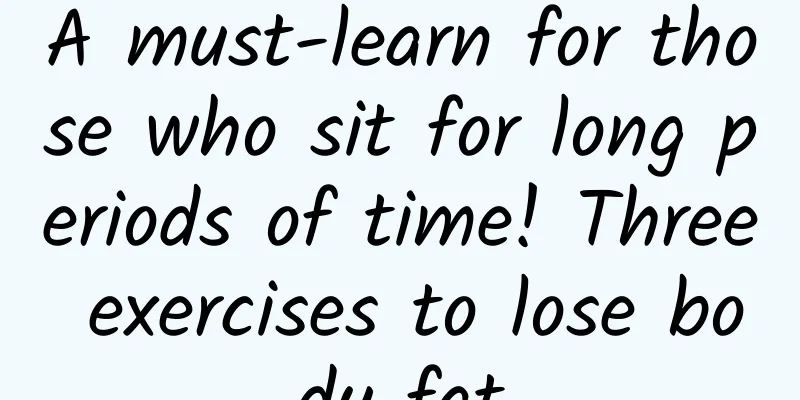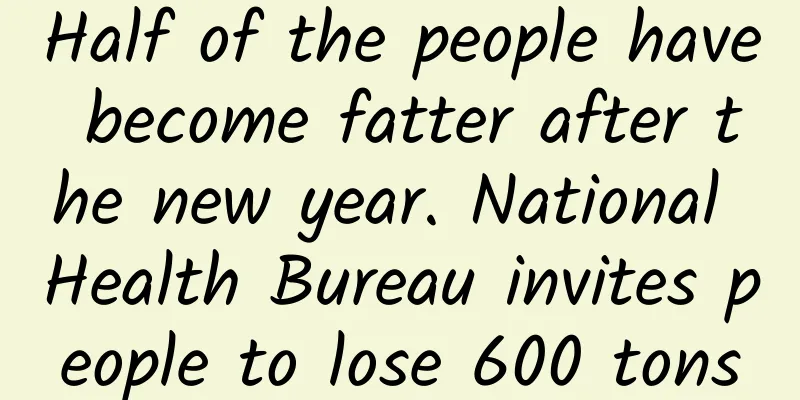A must-learn for those who sit for long periods of time! Three exercises to lose body fat

|
Whether standing up, walking, or bending over, every movement requires strong muscle strength. Starting from middle age, the rate of muscle loss accelerates, the muscle proportion is small, and it is easy to get tired. Proper muscle training is not only important for maintaining body shape, but also for maintaining physical fitness and vitality. The muscles of the human body can be divided into three types: cardiac muscle, smooth muscle, and skeletal muscle. Myocardial muscle is mainly located in the heart, while smooth muscle is distributed in the internal organs. These two types are "involuntary muscles" and cannot be controlled by consciousness, such as heartbeat and gastrointestinal motility. Only skeletal muscles connected to both ends of bones through tendons are "voluntary muscles" and can produce movements through skeletal muscle contraction. The so-called muscle training or sports training refers to the training of skeletal muscles. Even if your weight remains unchanged, skeletal muscle will gradually decrease from the age of 30. After the age of 40, the muscle mass will naturally decrease by an average of 8% every 10 years, resulting in less and less muscle mass, higher and higher body fat percentage, and a more bloated body shape. Once too much muscle is lost and muscle strength is insufficient, not only will the burden on bones and joints increase, causing back and waist pain, but the number of mitochondria, the energy factory in the muscles, and glycogen that can provide energy to the body will decrease, making people feel tired easily. Doing moderate muscle training early is very important to slow down muscle loss. However, if you are a middle-aged person who has not exercised for a long time, you may have some joint wear and tear. When doing the very popular fitness exercises such as the plank, which claims to be able to train the mermaid line, or the squat, which is said to be able to strengthen the buttocks and legs, if you do not pay attention to the key points of the movements, you may suffer sports injuries such as broken waist and knees. How can I correctly improve muscle quality if I haven’t exercised for a long time? What is the appropriate way to eat before and after exercise? This week, Zhang Gaohua, a physical therapist specializing in sports training, shares the key health-preserving methods of muscle training for middle-aged people. Stick style: Practice the mermaid line from simple to complex so as not to hurt your waist "Lie down, bend your elbows to 90 degrees, put your toes on the ground, tighten your abdomen and buttocks, and support your entire body. Make sure your head, shoulders, back, and buttocks are in a straight line." This is a very popular stick exercise in gyms and yoga studios. It is also called the plank pose and is often portrayed as an excellent basic training for exercising the mermaid line and vest line. Raising your hands horizontally, keeping your upper body straight, chest up, abdomen in, feet shoulder-width apart, center of gravity on your heels, and squatting with your hips back is considered the best weight training exercise for sculpting perfect buttocks, but is it really so? For people who haven't exercised for a long time, the purpose of the plank pose is mainly to train the core abdominal muscles, provide stability to the human spine, reduce pressure on the lower back, and make limb movements more efficient; it is also helpful for shaping the superficial muscle groups of the mermaid line and vest line. However, because the waist has a curvature, if the core muscles are weak and unable to provide effective support and stability, and you force yourself to do the plank pose, you will easily bend your waist and injure your waist. It is not suitable for patients who suffer from pain in the neck, shoulders or elbows. According to the principles of rehabilitation, it is recommended to first induce the core muscles to do simple plank poses, and then gradually progress to static plank poses, and even advanced dynamic plank poses, so that the power transmission of the limbs is more efficient, which is helpful for functional movements such as standing, walking, and running. In addition, things like panting when walking and difficulty going up and down stairs caused by insufficient muscle strength can naturally improve with the increase of muscle mass. Squat: In the early stages of slimming your buttocks, you can hold on to the back of a chair to prevent falling. Squats do not require you to simply bend your knees to do them. They also require your core abdominal muscles to contract slightly, starting with the hip joint in the pelvic cavity, and contracting the gluteus maximus and quadriceps to drive the natural bending of the knee joints. For people who exercise less, if incorrect movement patterns are used, the knee joints will be under great pressure, which may increase joint wear and tear and muscle strain. Over time, chronic knee pain will gradually emerge. This is an incorrect compensatory movement. The so-called compensatory movement refers to replacing the original movement with movements of other parts of the body when the limbs are not flexible enough or the muscle strength is unbalanced. When exercising muscle strength and producing incorrect compensatory movements, not only will the original sports training goals not be achieved, but further injuries may also be caused, so you must be careful. For office workers who sit in static jobs for long periods of time, squats can indeed effectively train the gluteus maximus in the buttocks and the quadriceps in the thighs, and are very helpful for lower limb muscle training. However, at the beginning, you may get injured due to insufficient muscle strength, incorrect movements, and unstable center of gravity. It is recommended to do it against a wall or with the back of a chair, which will be safer. And you should do it according to your ability, and there is no need to risk muscle strain in pursuit of endurance of the movement. The first condition for any muscle training is "to the best of one's ability". People who have not exercised for a long time or have had bone or muscle discomfort are advised to find a rehabilitation physician, physical therapist, or sports protector who specializes in sports training to first conduct a detailed assessment of personal movement tests to understand the joint movement angle, muscle strength and stability. Before and after exercise, pay attention to eating bread one hour before and drinking soy milk after For example, the neck will be bent, tilted back, and rotated; the shoulders will be flexed, extended, internally rotated, externally rotated, etc. to see if there are any angle restrictions or pain; the lower limbs will stand on one leg and squat to observe the limb movements and muscle balance, and then arrange training movements and plans suitable for the individual. One hour before muscle training, it is recommended to eat some carbohydrate, low-fat, easily digestible sugar foods, such as whole-grain bread, rice balls or bananas, to replenish the glycogen consumed during exercise. After exercise, replenish protein-rich foods, such as unsweetened soy milk, to help repair tiny tears in the muscles after exercise. However, it is not recommended to eat a large amount of high-protein foods, so as not to increase the burden on the kidneys; at the same time, too much protein will be converted into fat, increasing the accumulation of body fat. [Extended reading] 3 tips for safe muscle building Sedentary work often causes the abdominal and back muscles to lack exercise and become weak, and the lower limb muscles are prone to loss. You can do 3 exercises to strengthen your muscles. When exercising, the highest principle is to avoid compensatory movements and avoid soreness. (Sports technical instructor Huang Jianzhe demonstrates) 1. Simple plank pose: bend your elbows 90 degrees, kneel on your feet, tighten your abdomen, keep your neck, shoulders and back in a straight line, and alternately move your legs backwards and lift your knees off the ground to train your abdominal core muscles. 2. Overhead fly: Open your feet shoulder-width apart, bend your knees slightly, maintain the natural curvature of your waist, hold the dumbbells in both hands, lift them back and hold for 3 seconds, avoid shrugging your shoulders, which can train your back muscles. 3. Lunge Squat: Hold the back of the chair, take turns to squat with one foot taking a step forward, the front knee should not exceed the toes, the back knee should be bent close to the ground, and keep the torso straight up and down to train the lower limb muscles. ※ For the full text, please see Business Weekly. |
<<: Zeng Kaixuan's fever subsided quickly after giving birth! Slimming Techniques Revealed
>>: So fat! 1 cup of hot bubble tea = 28 sugar cubes
Recommend
168 Is fasting super effective for weight loss? Eating the wrong food for a long time may cause loss of muscle! 4 health risks you must know
There are hundreds of ways to lose weight, among ...
Sculpting soft lines with water jet autologous fat transplantation
Does Queen A-mei need liposuction? This topic has...
Three dietary treatments for ovarian cyst patients
Patients with ovarian cysts should strengthen the...
The reasons why girls are prone to irregular menstruation
The most common symptom of women during menstruat...
How to treat uterine fibroids and ovarian cysts
The treatment of uterine fibroids and ovarian cys...
What causes pelvic inflammatory disease?
What causes pelvic inflammatory disease? This is ...
Overview of threatened miscarriage
Threatened abortion has a great impact on pregnan...
Symptoms of systemic pelvic inflammatory disease are usually mild.
Since the symptoms of pelvic inflammatory disease...
Ectopic pregnancy may be caused by chronic pelvic inflammatory disease
Ectopic pregnancy may be caused by chronic pelvic...
What are the symptoms of postpartum cervical erosion? Five things to pay attention to in the treatment of postpartum cervical erosion
The process of childbirth for women is very painf...
Briefly describe the symptoms of acute pelvic inflammatory disease
Acute pelvic inflammatory disease refers to an ac...
How to distinguish between bacterial vaginosis and trichomoniasis
Vaginitis is a common problem encountered in obst...
Can Traditional Chinese Medicine Cure Cervical Precancerous Lesions?
Can Chinese medicine cure cervical precancerous l...
Can I wear an IUD when I have uterine fibroids?
Can I wear an IUD when I have uterine fibroids? 1...
How much does pelvic inflammatory cream cost?
Pelvic inflammatory disease is a common gynecolog...









